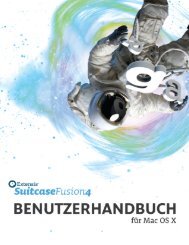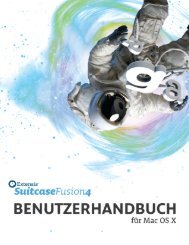Suitcase Fusion 3 User Guide for Mac OS - Extensis
Suitcase Fusion 3 User Guide for Mac OS - Extensis
Suitcase Fusion 3 User Guide for Mac OS - Extensis
Create successful ePaper yourself
Turn your PDF publications into a flip-book with our unique Google optimized e-Paper software.
Option 2: Adding fonts in place<br />
If you prefer to store fonts with specific jobs, or if you have a font organization system that you prefer, you can<br />
set up <strong>Suitcase</strong> <strong>Fusion</strong> to leave fonts in place.<br />
If you add fonts from removable media, <strong>for</strong> example CDs or DVDs, and you don’t have enough space on your<br />
hard drive to store all these fonts, you can add these fonts to <strong>Suitcase</strong> <strong>Fusion</strong> by choosing the Add fonts<br />
leaving them in place option in the Preferences dialog box. This allows you to catalog all your fonts without<br />
storing them all on your hard drive. When you want to use these fonts, you will have to mount the appropriate<br />
volume; <strong>Suitcase</strong> <strong>Fusion</strong> will notify you when the need arises.<br />
To have <strong>Suitcase</strong> <strong>Fusion</strong> leave fonts in place:<br />
1. Choose <strong>Suitcase</strong> <strong>Fusion</strong> 3 > Preferences.<br />
2. Enable the Add fonts leaving them in place option.<br />
When you add fonts, your font files will remain in place and they will not be added to the vault.<br />
Of course, you could also choose to add fonts to an entirely separate font library (File > New Library). This way<br />
the fonts would be stored in your Font Vault, but would not be mingled in with the rest of your font collection.<br />
Advertising Agency or Workgroup Publisher Sample<br />
Setup<br />
If more than one computer is involved in your publishing process, font management becomes extremely<br />
important. Any variation in fonts can cause missing fonts problems, inaccurate substitutions, and text reflow. In<br />
addition, administrators must ensure that the company owns licenses <strong>for</strong> the fonts used in all projects. You can<br />
use <strong>Suitcase</strong> <strong>Fusion</strong> features to control these issues or upgrade to a more powerful server-based font<br />
management system.<br />
With a stand-alone font manager, each user must manage their own fonts as a freelance graphic designer would.<br />
Each user maintains his or her own font library stored in his or her own vault.<br />
If the <strong>Suitcase</strong> <strong>Fusion</strong> users are working over a network on the same documents—<strong>for</strong> example, at a site using<br />
QuarkXPress—users can still manage their own fonts. To prevent problems, the users must obtain their fonts <strong>for</strong><br />
common jobs from the exact same source. For example, if a user receives a CD or DVD of fonts with Adobe<br />
InDesign, they cannot be sure that the font versions are the same as fonts received on a CD with Adobe<br />
Photoshop.<br />
The administrator should create the master folder of fonts, ensuring that all the fonts in the folder have been<br />
properly licensed by the company, and that the company owns sufficient licenses <strong>for</strong> each of the fonts. The<br />
administrator can distribute this folder to each of the users in the workgroup by copying the folder of fonts to<br />
each user’s computer, or placing the folder in a network location so each user can download and add the fonts<br />
to <strong>Suitcase</strong> <strong>Fusion</strong> themselves. <strong>User</strong>s should add fonts to the Font Vault on their local computer. The<br />
administrator can add fonts to the master folder, and users can then periodically add the entire folder to<br />
<strong>Suitcase</strong> <strong>Fusion</strong>. Duplicates are prevented from being added to the vault, so only new fonts the folder will be<br />
added to a user’s Font Vault.<br />
For special projects, the users can add fonts to <strong>Suitcase</strong> <strong>Fusion</strong> using the Add fonts leaving them in place<br />
preference. By choosing to add fonts in place, new fonts are not added to the user’s Font Vault, and only<br />
approved fonts remain in the Vault.<br />
<strong>User</strong>s can further organize fonts from special projects using Libraries and Sets. If it’s important that fonts aren’t<br />
stored together and not used across clients, the user can create a library <strong>for</strong> each client and only add fonts <strong>for</strong><br />
each client in each library. If the user only wants to create a group of fonts as a reminder of which fonts were<br />
used <strong>for</strong> each client, keep all of the fonts in one library and create a set <strong>for</strong> each client. Each client set can be<br />
further organized by creating nested sets <strong>for</strong> each project.<br />
For example, an agency doing work <strong>for</strong> multiple movie studios could make a library <strong>for</strong> each studio. Then within<br />
each library a new set would be created <strong>for</strong> each movie, and nested within each movie set could be sets <strong>for</strong><br />
specific projects like movie poster, DVD cover, etc.<br />
- 19 -









